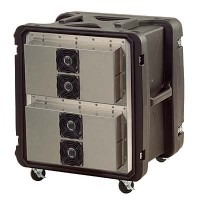
For shipping and transit cases, traditional refrigeration technology is giving way to thermoelectric cooling. Here’s why:
Since there’s no refrigerant or compressor, a thermoelectric cooling unit can be mounted in any orientation. This gives the transit case designer more flexibility to utilize available space. And, if the case is tipped up or stood on end, it keeps working (but make sure air can flow over the hot side!).
Portability is a top concern in a transit case. Anything that adds weight, other than the payload, is a definite negative. Because of their solid-state electronic construction, thermoelectric coolers are the lowest-mass means of controlling temperature. And that leaves more space for the all-important contents.
Manufacturers quote MTBF’s of up to 150,000 hours for thermoelectric coolers. There’s just nothing to wear out or breakdown. That’s 17 years of uninterrupted operation! Compare that to compressor systems where seals become brittle; bearings wear; gas escapes.
When you’ve put delicate electronics in a transit case, the last thing you want is a pump hammering against the side. That can fatigue the contents – as well as anyone working nearby. Avoid disturbing compressor noise and the added weight you have to transport. Instead, choose a thermoelectric system. They are silent – except for the soft whirr of fans – and lightweight.
Many electrical systems – the kind you want to put in a transit case – are susceptible to electromagnetic interference (EMI) produced by a compressor system. But, by virtue of being low voltage and solid-state, a thermoelectric cooler has practically zero electrical emission.
Some environments are hot in the day and cold at night. That can lead to condensation and all the associated problems. But, because the thermoelectric effect is reversible, it’s actually possible to turn the cooler into a heater, preventing the case contents from getting too cold.